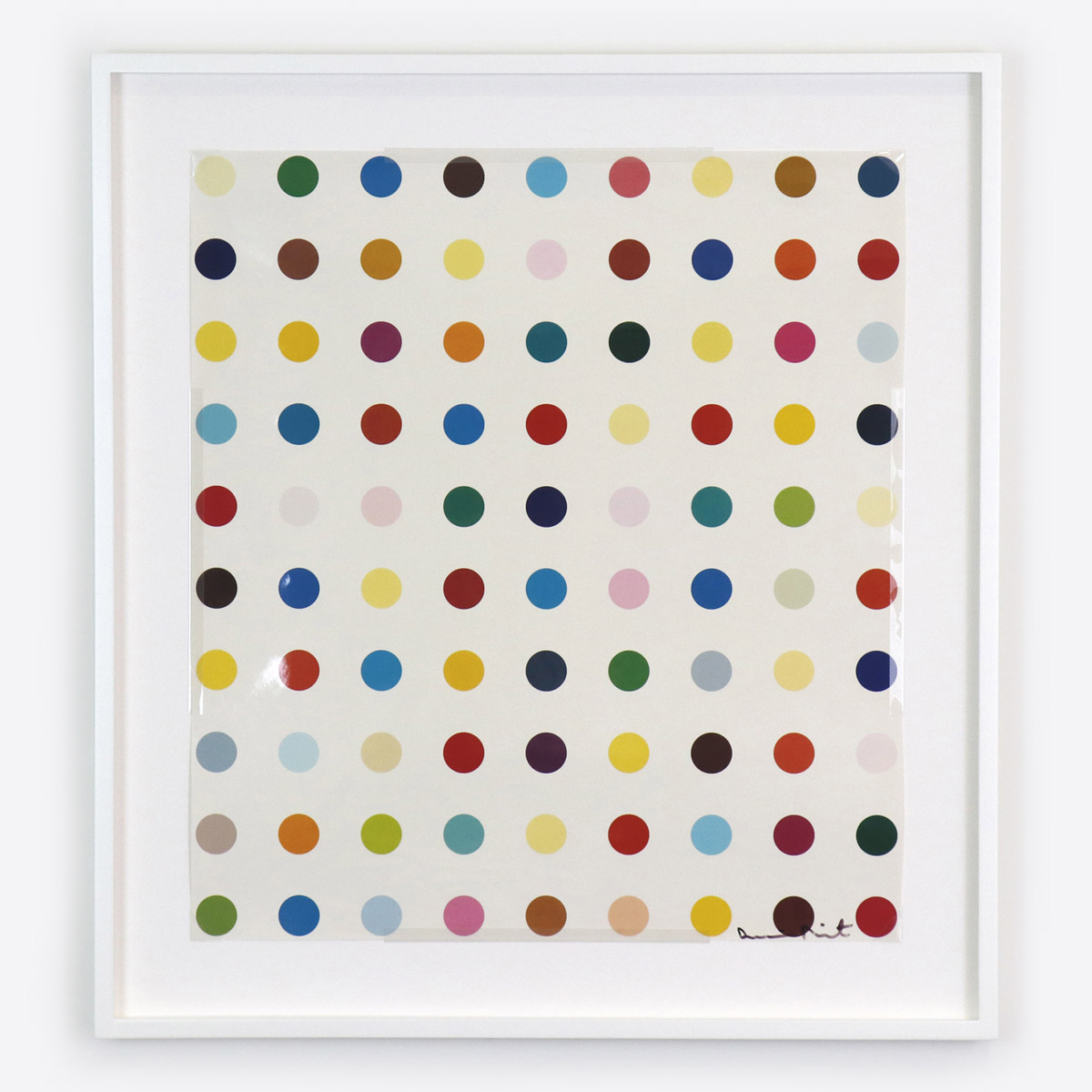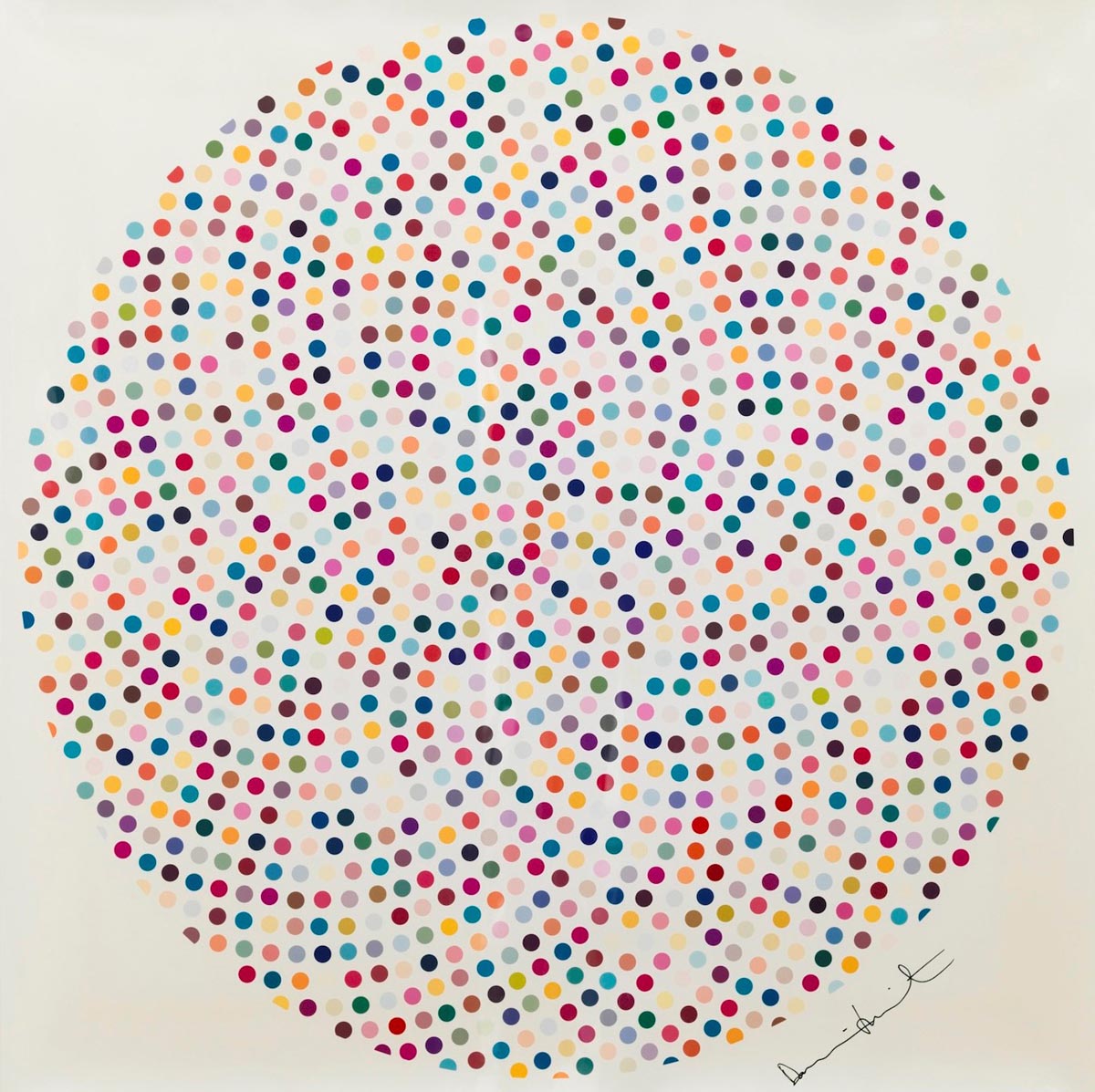The most influential British contemporary artist of a generation,
Damien Hirst has inspired, provoked and divided the public, collectors and critics. Contradicting themes of beauty and decay, infinity and mortality, has led to a wide body of works, including displays of medicine cabinets; ‘Pharmaceutical’ spot paintings; and preserved sharks, sheep and cows in formaldehyde. At the dawn of the new millennium Hirst was already an established artist, rising to global fame in less than a decade. The three historical print editions
Valium,
Lysergic Acid Diethylamide (LSD) and
Opium from Hirst’s ‘Pharmaceutical’ series were released during the summer of 2000 in an exclusive collaboration with Eyestorm.
Flawless colourful dots in perfect grids and patterns, painted on white canvas with household gloss paint. At distance
Damien Hirst’s spot paintings may look uncomplicated and visually similar to a pattern of modern design. To the artist the series of pharmaceutical spot paintings are closer to sculptural works of art based on a conceptual practice of exploring colour, patterns and shape - and leaving much of the interpretation to the viewer. To Hirst - art needs no proof.
The origin of the spot paintings came at the time when the artist was enrolled into the Fine Art course at Goldsmiths University in London in the mid-eighties. Hirst and his fellow students provoked the public’s perception of art and challenged the artworld establishment. Tracey Emin with her ‘Unmade bed’ made of dirty sheet, pill jars and bottles of alcohol; Gary Hume’s hospital swing door paintings using bold colours and negative space; and later
Martin Maloney’s colourful work of people in everyday intimacy, delivered in a childish and expressionist form. In the years that followed this group of young artists would propel ahead into the nineties and collectively be known as “the YBAs”: the Young British Artists.
At Goldsmith, Hirst worked intensely with bright, cheerful and warm colours. His first spot painting was created on three large panels and simply titled ‘Spot Painting’ (1986); a composition of irregular spots, more like blobs, some dripping or running down the panels when too much paint was applied in the process. The artist found inspiration from the sixties’ abstract expressionists, who painted emotionally and “violently”, often splashing paint on the canvas to express their inner psychological thunderstorms in the moment. However, in ‘Spot Painting’ Hirst maintains some inner control, resulting in a warm, positive and comforting piece. Looking at the painting, the red, violet and darker hues forms the first impression - and shortly after the lemon yellow, lime green and pink emerge from the surface.
_2000.jpg)
DAMIEN HIRST
Lysergic Acid Diethylamide (LSD), 2000
Edition of 300
127(w) x 106(h) cm
50.00(w) x 41.93(h) inches
_2000.jpg)
DAMIEN HIRST
Lysergic Acid Diethylamide (LSD), 2000
Edition of 300
127(w) x 106(h) cm
50.00(w) x 41.93(h) inches
|
|
|
127(w) x 106(h) cm
50.00(w) x 41.93(h) inches
|
Lambda Chromogenic print.
Signed on the front and numbered on verso.
Print in excellent condition.
Drymounted to aluminium, framed as floated in a white wood frame and UV perspex.
Certificate of Authenticity by Eyestorm.
Edition of 300
|
PRICE
|
$ 25,500.00
|
|
Private Sales
|
|
Hirst continued exploring sculpture and colours as the years progressed. The sculpture ‘8 Pans’ (1987) led indirectly, though perhaps subconsciously, to the renowned spot paintings. Eights cooking pans in different sizes on a wall with the bottom surface facing outwards, painted with gloss paint in block colours: bright green, red, blue and yellow. Hanging in a straight line next to each other, unwittingly referencing how our planetary system is often depicted in science books, the viewer can ignore the everyday pans as a medium - and focus on the eight perfectly round colourful circles. It is easy to envisage how the sculptural piece gave Hirst an ability to create perfection in the use of colour, size and geometrical shape.
The spot paintings on canvas with the impeccable round dots were first exhibited in East London in July 1988 at the legendary ‘Freeze’ exhibition; a remarkable exhibition orchestrated by Hirst, showing works by sixteen Goldsmiths’ graduates. In two years, Hirst had developed his practice from the expressionist ‘Spot Painting’ to works on clinical white canvas with equally sized dots in a multitude of colours. The methodology of the spot painting put Hirst in full control and played well into his interest in conceptual art; an art movement where the thought-process behind the work is fundamental.
The interaction between colours and how each colour affects the one next to it had been explored by colour theorists before Hirst, most notably by the German artist Josef Albers, famous for his colour theory and the book ‘Interaction of Colour’ published in 1963. Rather than theorising about colours and their physical properties, Hirst referred to colours as emotions or “moods”: red as passion; green as envy; yellow as happiness; and pink as affection. With the artist’s scientific approach, the spot paintings examined colour interaction and mood. The size of the canvases would vary and so would the diameter of the dots, some painted as half-circles. At the same time, the series would always follow a conceptual rule that neither of two dots could have the same exact colour.

DAMIEN HIRST
Opium, 2000
Edition of 500
43(w) x 48(h) cm
16.93(w) x 18.90(h) inches

DAMIEN HIRST
Opium, 2000
Edition of 500
43(w) x 48(h) cm
16.93(w) x 18.90(h) inches
|
|
|
43(w) x 48(h) cm
16.93(w) x 18.90(h) inches
|
Lambda Chromogenic print
Signed on the front and numbered on verso.
Edition of 500
|
PRICE
|
$ 13,795.00
|
|
Private Sales
|
|
From a conceptual angle, the thought of creating a series of works that would have endless possibilities fascinated Hirst - and he could achieve it with the new series of spot paintings. With a possibly infinite series, the artist was looking for a similar limitless source to title each work. In his second year at Goldsmiths, the artist was simultaneously working on a series of medicine cabinets; another series of work for which Hirst would claim artistic fame and glory. As he was filling the cabinets with the packaging for medical pills, mixture bottles and little plastic containers, he stumbled across the source of titles he needed: a catalogue from Sigma-Aldrich Pharmaceutical. Pages and pages with intriguing - though frequently unpronounceable - titles of drugs would form the basis of the titles for his ‘Pharmaceutical’ spot paintings.
In the summer of the new millennium, Hirst released the first print editions as part of his ‘Pharmaceutical’ spot series.
Valium,
Lysergic Acid Diethylamide (LSD) and
Opium followed the same approach as the painting and were printed as chromogenic prints to appear identical to the gloss surface seen on the work on canvas. For this series, with a large edition size in the hundreds and thus available to a wider group of collectors, Hirst chose pharmaceutical names of three drugs with a questionable reputation of stimulating the neurotransmitters in the brain. The names of the drugs he knew would ring a bell with the public.

DAMIEN HIRST
Valium, 2000
Edition of 500
127(w) x 127(h) cm
50.00(w) x 50.00(h) inches

DAMIEN HIRST
Valium, 2000
Edition of 500
127(w) x 127(h) cm
50.00(w) x 50.00(h) inches
|
|
|
127(w) x 127(h) cm
50.00(w) x 50.00(h) inches
|
Lambda Chromogenic print
Signed on the front and numbered on verso.
.
Edition of 500
|
|
Lysergic Acid Diethylamide (LSD) and
Opium were created in a square grid with the hues in red, yellow and darker spectrum being prevailing, although for
Valium also the blue hues are part of the first visual impression.
Valium stands out with its rounded shape and patterns spinning outwards from the centre, creating a hallucinating effect, referring back to the psychedelic drugs. As well as the paintings on canvas, all three works follow Hirst’s conceptional idea of a scientific approach to colour and the characteristics of the grids bring associations to molecular structures.
Over the fifteen years between 1986 and 2011, Hirst created 1,400 spot paintings. Except for 25 paintings painted by himself, the majority were painted by art students such as
James Hunter, who used this working experience as an important step for his artistic career. The idea of an artist not painting the work by himself was not invented by Hirst and goes as far back as the old Renaissance masters of the 15th century. In the sixties Andy Warhol reinvented this controversial practice at ‘The Factory’; Warhol’s super productive studio on East 47th Street in New York.
The media was quick to ridicule Hirst and his response was not without humour. In 2001, he released the edition
Painting by Numbers; a cardboard box containing 90 white brushes, 90 small buckets of paint each with a number on the lid - and a canvas with pre-printed outlines of 90 dots with a number inside. Now everyone could be one of Hirst’s assistants by simply following the same rules as in the popular colouring books for children.
_2001.jpg)
DAMIEN HIRST
Painting-by-Numbers (Red), 2001
Edition of 175
80(w) x 54(h) cm
31.50(w) x 21.26(h) inches
_2001.jpg)
DAMIEN HIRST
Painting-by-Numbers (Red), 2001
Edition of 175
80(w) x 54(h) cm
31.50(w) x 21.26(h) inches
|
|
|
80(w) x 54(h) cm
31.50(w) x 21.26(h) inches
|
Cardboard box comprising of a stretched canvas with 90 enamel paints and 90 brushes.
Canvas stamp-signed in red on verso.
Framed in two perspex boxes; one containing the cardboard box and polyfoam packaging, and a smaller one with the empty canvas.
Edition of 175
|
PRICE
|
$ 22,070.00
|
|
Private Sales
|
|
In January 2012, Gagosian Gallery opened its doors to all eleven gallery spaces around the world to ‘The Complete Spot Paintings 1986 - 2011’; an unprecedented exhibition showing more than 300 of Hirst’s spot paintings. A few months later, a brilliant retrospective of Hirst’s comprehensive body of work from 1986 to 2008 was on display at Tate Modern in London.
Valium,
Lysergic Acid Diethylamide (LSD) and
Opium were released in 2000 in an exclusive collaboration between
Damien Hirst and Eyestorm. The Lambda chromogenic-type prints were released in editions of 500 for
Valium and
Opium, and in an edition of 300 for
Lysergic Acid Diethylamide (LSD). Forming part of the early history of the gallery - and the most popular works released by Eyestorm in the past two decades - the three print editions are today regularly appearing at major auction houses.
You can find more details about the three print editions, and other works, on
Damien Hirst artist page
here.